You’ve passed all the tests, and so have they. Now, you’ve been hired by an awesome organization and your first day is approaching. How are you preparing to make the most of your transition period? You won’t get a second chance to make a first impression, and the first 90 days in your new leadership role may be the most critical time in your entire executive tenure. It is in this first critical stretch when the window for change is open the widest, and the tone for a leader’s entire tenure is set.
It typically takes a senior leader this long to add value, and six months (or more) to reach full performance. With an aggressive, purposeful approach to the first 90 days, the timeline to add value can be shortened. The window of opportunity can be leveraged, and the foundation established for long term success. Here are five tips to make the most of your transition.
1. Start with hypotheses
Before your first official day, dig into as much as you can. Use what you learn to formulate early hypotheses about vision, process, people, and problems facing the team. What do you believe is off about the current vision? What’s broken about the team’s processes? Who might be in the wrong seat? What are potential solutions to tactical challenges? Simplify your hypotheses and document them in your action plan.
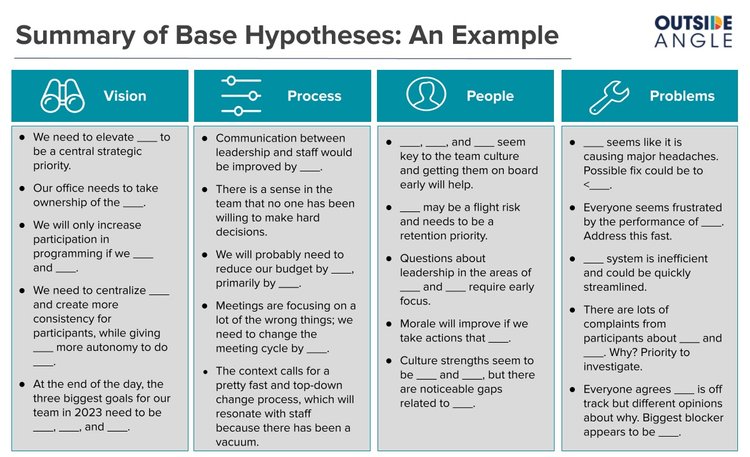
2. Go in with a plan
Map out your first 18 weeks. Double-click on the first six, mapping out key 1:1s, “deep dives” you will ask staff to prepare for you, any relevant site visits you will make, and documentation you will want to read. Use these activities to test and iterate on your hypotheses. Ask the hard questions and learn as much as possible.
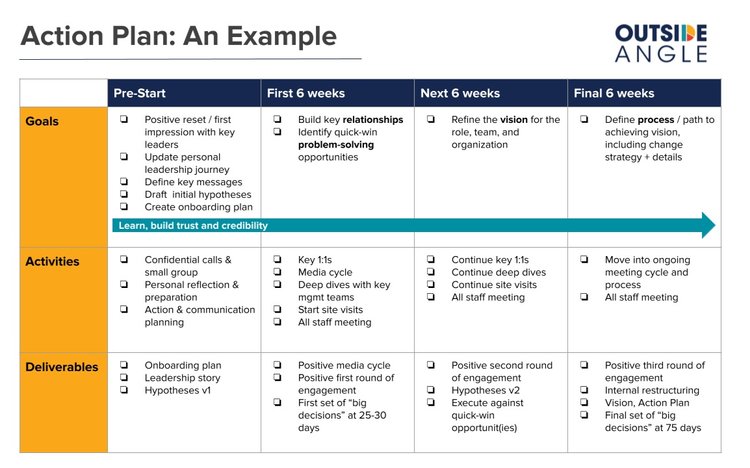
This is an example action plan for a transitioning executive’s first 90 days.
3. Set mileposts that hold you accountable
Right off the bat, schedule a sequence of engagements with your team. Getting these on the calendar immediately will hold you accountable to your plan. They should include report-outs to your team at 30, 60, and 90 days. These can be quick briefings or deeper engagements depending on the context, but they have to happen.
At each briefing, the team should see your hypotheses evolving based on what you’ve learned. They should also see some of these ideas moving from hypotheses to decisions. This process helps you establish credibility, build trust, and generate momentum.
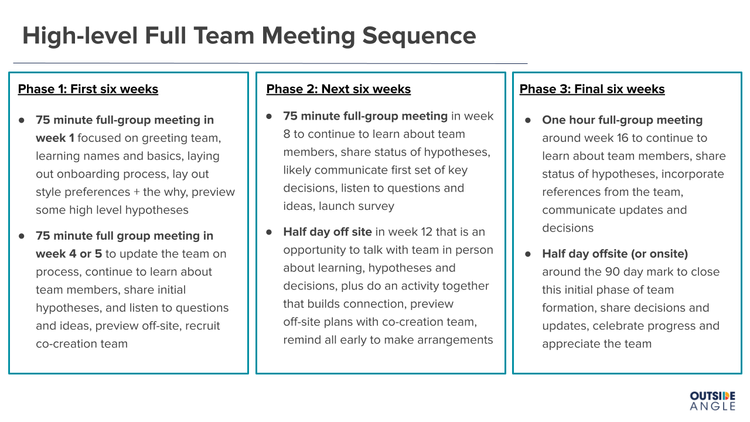
Here, a series of full team meetings is mapped out. Doing this creates mileposts in a process that moves you—and your hypotheses and ability to enact change—forward, from your initial days through day 90.
4. Test your messages
As you move through your 1:1s, deep dives, and site visits, you have the opportunity to test and strengthen how you communicate your hypotheses and decisions. This is a huge opportunity not to be underestimated. It means that by the time you are standing up in front of the full team for your 30 or 60 day briefings, you should already have a good feel for how to deliver the content. You will already have had the opportunity to test your messages with key team members to minimize surprises and set up the bigger conversation to be as well received as possible, even if it includes confronting some hard truths and making some needed changes (which it should!).
5. Go HAM
If you don’t take control of this transition period from day one, it will take control of you. Play offense, or you’re going to get pulled in a million directions. The 90 days will fly by, and you’ll never have another opportunity like it again. So be clear with yourself and others about the principles that will guide your process.
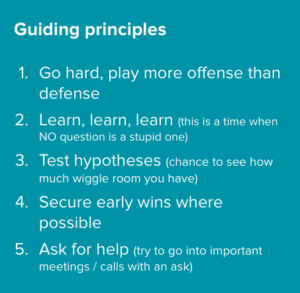
Finally, remember that building trust and credibility is a key goal. Being liked is important, but being trusted is imperative. People will be watching extra carefully during this time, so use your transition plan as a place to show alignment between actions and words, and do what you say you will.
Conclusion
The first 90 days of leaders’ tenure are critical. If a leadership transition succeeds, the leader’s tenure will probably be successful over several years. A structured and strategic process maximizes the likelihood of success.
Unfortunately, many leaders get sucked right into the daily flow of the organization, and their first day doesn’t look very different from their 90th or 900th. Don’t allow that to happen to you, or to the next leader you hire. Do everything you can to create space for them to onboard in the ways described above and you will help set them and entire organization up for long term success.
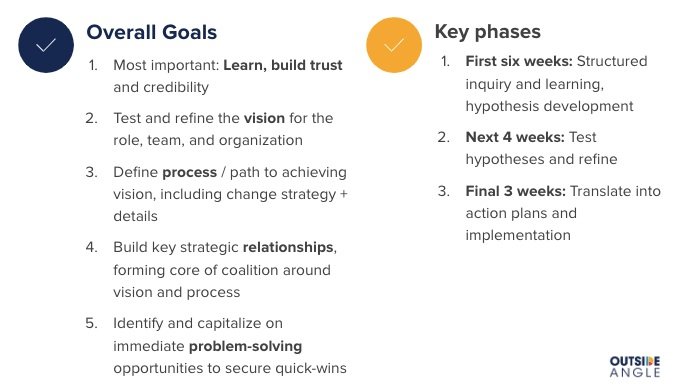
We recommend that you use these goals to drive your 90-day onboarding period.
Need help?
Outside Angle helps transitioning leaders develop a plan that focuses and structures their first 90 days. We also help these leaders execute and adjust their plan as they go. Here’s a little about how it works.
-
Ideally the work begins before day one. We work with a transitioning executive before they start to create a learning agenda, 5-week action plan, leadership story, and initial hypotheses related to vision, process, relationships, and quick-win opportunities.
-
During the first five weeks we focus on structured inquiry, learning, and hypothesis development. Here, the executive executes the planned learning agenda and action plan. The leadership story is leveraged to help introduce the new executive to the team, organization, and field.
-
During the next four weeks we help the new executive test and refine their hypotheses in a way that builds trust and credibility. By making hypotheses transparent, and gaining feedback through multiple channels, the executive is able to accelerate learning, while iterating on their ideas. This is also the period during which we help the executive start to execute against quick-win opportunities.
-
During the final three weeks we help the executive translate their hypotheses into action plans and implementation. By the end of the onboarding process, the goal is to have a clearly defined strategic vision, a change strategy or process plan, positive relationships with key stakeholders, and tangible momentum established through quick wins and tough but informed decisions.
Transitioning soon to a new role and need some support? Don’t hesitate to reach out.

